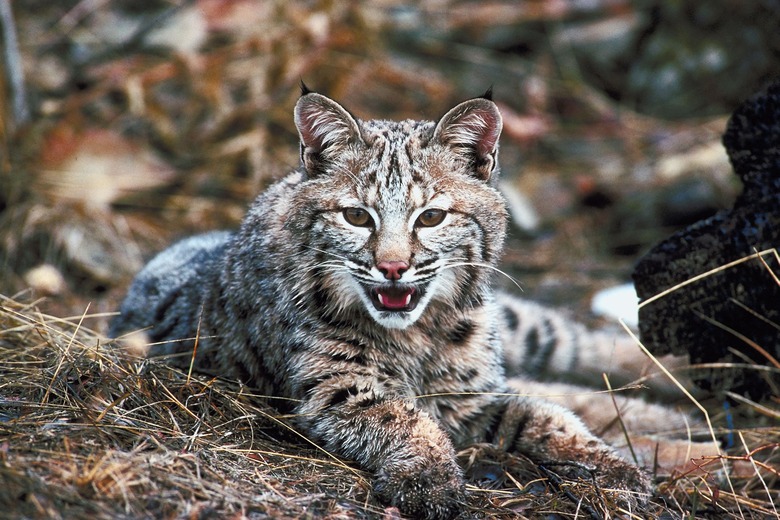The Ecosystem Of Bobcats
Bobcats (scientific name for the bobcat animal is Lynx rufus) are the most widespread predator in North America, ranging from Mexico to Canada. Some researchers have suggested that the bobcat is a "keystone species." A keystone species is one that has a disproportionate effect on the ecosystem that it lives in, relative to its biomass. Predators are commonly named as keystone species because their populations are relatively sparse, yet they exert considerable influence on lower levels of the food chain.
Diet
Diet
The bobcat is a generalist predator — this means that it has the ability to prey on a diverse range of prey species. This is due, in part, to its versatile size. The bobcat, roughly the same size as a coyote, is big enough to take down small deer and pronghorn antelope, but small and agile enough to capture small prey.
A study carried out by Idaho Fish and Game staff, published in a 1988 issue of "Northwest Science," found that bobcats ate a total of 42 different species within a year in Oregon's Cascade Ranges. Hares, black-tailed deer and beavers made up the bulk of the annual diet, but bobcats also ate a range of small mammals, birds, reptiles and even insects.
Top-Down Bobcat Ecosystem Control
Top-Down Bobcat Ecosystem Control
As a top predator the bobcat is at, or near, the top of the food chain. This position on the bobcat food chain is a critical one, because the bobcat exerts what is known as "top-down control" of ecosystems. Bobcats and other predators help to keep ecosystems balanced. In ecosystems that are short on predators, consumers lower in the food chain rapidly increase in population size.
This over-taxes food resources, leading to poorer condition of individuals and higher rates of starvation. Eventually, low birth rate and high mortality will cause consumer populations to crash, but in the meantime, the effects have filtered down to plant communities. Over-grazing by herbivores can result in very low biomass of some plant species. This in turn affects invertebrate communities, and can inhibit nutrient cycling.
Kiawah Island
Kiawah Island
Increasing encroachment of urban areas into previously wild ones has led to urbanization of many wildlife species, including deer, raccoons and possums. On Kiawah Island, South Carolina, the survival rate of white-tailed deer is unnaturally high because there are few predators in this predominately suburban landscape. With a view to restoring natural ecosystem balance, local authorities have collaborated with researchers to discover ways to increase habitat suitability for bobcats.
An article published in the April 2010 issue of the "Journal of Wildlife Management," along with current research on Kiawah Island, indicate that encouraging landowners to provide and preserve suitable habitat for bobcats could be a successful method of restoring predator-prey relationships in suburban areas.
Cumberland Island
Cumberland Island
Cumberland Island, Georgia, was devoid of large predators until bobcats were released as part of an ecosystem restoration project in 1989. The results of the project are reported in a 2009 compilation on Lynx conservation, titled "Iberian Lynx Ex Situ Conservation: an Interdisciplinary Approach." With no pressure from predators, native and introduced herbivores were rampant on the island. Over-grazing and browsing was causing damage to native plant communities, with white-tailed deer identified as one of the chief culprits.
Bobcat diets were monitored between 1980 and 1998. Researchers found less deer in bobcat diets over time, indicating that bobcats had initially used deer as a primary prey species but ate them less often as they became scarcer. Regeneration of native oak significantly increased over this time period, further evidence that bobcats were keeping deer numbers low. Body weights of deer increased by 11 kilograms, on average, between 1989 and 1997, illustrating the importance of bobcats in keeping prey populations healthy.
References
- IIS7 Internet Information Service: Iberian Lynx Ex Situ Conservation: an Interdisciplinary Approach
- Fish and Wildlife Service Publications: Bobcat Population Status and Management in North America: Evidence of Large-Scale Population Increase.
- Cumberland Island Journal: Bobcats on Cumberland Island
- University of Kentucky: Bobcat
Cite This Article
MLA
Campbell, Kirsten. "The Ecosystem Of Bobcats" sciencing.com, https://www.sciencing.com/ecosystem-bobcats-22254/. 31 July 2019.
APA
Campbell, Kirsten. (2019, July 31). The Ecosystem Of Bobcats. sciencing.com. Retrieved from https://www.sciencing.com/ecosystem-bobcats-22254/
Chicago
Campbell, Kirsten. The Ecosystem Of Bobcats last modified August 30, 2022. https://www.sciencing.com/ecosystem-bobcats-22254/
